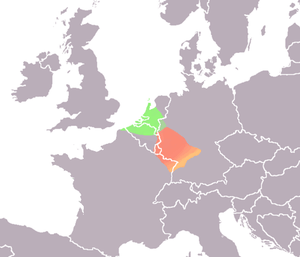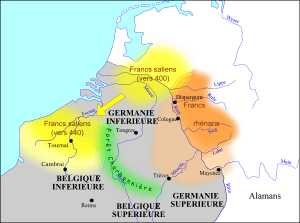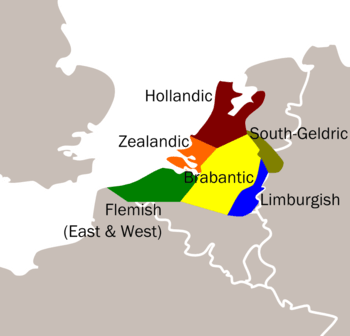Low Franconian languages
| Low Franconian | |
|---|---|
| Low Frankish, Nederfrankisch | |
| Geographic distribution | Netherlands, northern Belgium, northern France, western Germany, Suriname, Netherlands Antilles, Aruba, Namibia and South Africa |
| Linguistic classification |
Indo-European
|
| Proto-language | Frankish |
| Subdivisions | |
| Glottolog | wese1235 (Low Franconian (Weser–Rhine))[1] |
 Franconian-speaking dialects in Europe (Dutch, as standard language spoken in the whole of the Netherlands, and itself a Low Franconian language, not indicated on this map):
Low Franconian dialects in the Netherlands, Belgium, Germany (Meuse-Rhenish) and France (French Flemish)
| |
Low Franconian, Low Frankish (Dutch: Nederfrankisch, German: Niederfränkisch, French: Bas Francique) are a group of several West Germanic languages spoken in the Netherlands, northern Belgium (Flanders), in the Nord department of France, in western Germany (Lower Rhine), as well as in Suriname, South Africa and Namibia that originally descended from the Frankish language.
Frankish language
The Frankish language, also "Old Frankish", was the language of the Franks. It is a West Germanic language and was spoken in Merovingian times, preceding the 7th century. Austrasia formed the northeastern portion of the Kingdom of the Merovingian Franks (Francia), comprising parts of the territory of present-day western Germany, eastern and northern France, Luxembourg, Belgium, and the Netherlands. The Franks first established themselves in the Netherlands and Flanders before they started to fight their way down south and east. The language had a significant impact on Old French. It evolved into Old Dutch in the north and it was replaced step by step by the langues d'oïl in the south.
Old Frankish is not directly attested except in glosses and small phrases. It has been reconstructed using the comparative method from loanwords in Old French and from Old Dutch. One known phrase in Old Frankish is found in the Salic law of the early sixth century, and is used to free a serf:
Maltho thi afrio lito.
I say to you, I free you, half-free.
Old Low Franconian (also Old Low Frankish) was a group of dialects spoken in the Low countries. It was a daughter language of the Old Frankish language.
Development

Old Low Franconian is sometimes divided in two groups, Old Dutch (also Old West Low Franconian) and Old East Low Franconian. Because the two groups were so similar it is often very hard to determine whether a text is Old Dutch or Old East Low Franconian, most linguists will generally use Old Dutch synonymously with Old Low Franconian and most of the time do not differentiate.
Regardless of this difference in interpretation, East Low Franconian was eventually "absorbed" into Dutch as it became the dominant form of Low Franconian, although it remains a noticeable substrate within the Limburgish language.[2]
Development of Dutch
Dutch, like other Germanic languages, is conventionally divided into three phases. In the development of Dutch these phases were:
- 425/450–1150: Old Dutch
- 1150–1500: Middle Dutch (also called Dietsch in popular use, though not by linguists)
- 1500–present: Modern Dutch (saw the creation of the Dutch standard language and includes contemporary Dutch)
Low-Franconian varieties are also spoken in the German area along the Rhine between Cologne and the border between Germany and the Netherlands. During the 19th and 20th centuries these dialects have partly and gradually been replaced by today's Standard German. Sometimes, Low Franconian is grouped together with Low German. However, since this grouping is not based on common linguistic innovations, but rather on the absence of the High German consonant shift and Anglo-Frisian features, modern linguistic reference books do not group them together.[3]
Modern Low Franconian languages

The contemporary continental Low Franconian language area is decreasing in size. French Flanders has become more and more francophone during the last century. Brussels Capital Region is officially bilingual, but largely francophone. In Germany, Low Franconian only exists as Meuse-Rhenish regiolects and dialects.
Dutch
The main dialects are:
- Brabantian
- East Flemish
- Hollandic
- Limburgian
- Zealandic
- West Flemish
- South Guelderish (also called Kleverlandish or Clevian)
Meuse-Rhenish
It is common to consider the Limburgish varieties as belonging to the Low Franconian languages; in the past, however, all these Limburgish dialects were sometimes seen as West Central German, part of High German. This difference is caused by a difference in definition: the latter stance defines a High German variety as one that has taken part in any of the first three phases of the High German consonant shift. Limburgish is also spoken in a considerable part of the German Lower Rhine area, in what could be called German-administered Limburg: from the border regions of Kleve, Aachen, Viersen, Heinsberg stretching out to the Rhine river. At the Rhine near Duisburg, it adjoins a smaller strip of other Low Franconian varieties called Bergisch. Together these distinct varieties, now often combined with the Kleve dialects (Kleverländisch) as Meuse-Rhenish ('Rheinmaasländisch'), belong to the greater Low Franconian area between the rivers Meuse and Rhine (A. Welschen 2002). Limburgish straddles the borderline between 'Low Franconian' and 'Middle Franconian' varieties. They are more-or-less mutually intelligible with the Ripuarian dialects, but show fewer 'High German shifts' (R. Hahn 2001). In a number of towns and villages in the north-east of the Belgian province of Liege, such as Hombourg, Welkenraedt, and Eupen, a transitional Limburgish-Ripuarian dialect is spoken, called Low Dietsch (Dutch: Platdiets, Limburgish: Platduutsj, French: Thiois or Platdutch).
Afrikaans

Afrikaans is an Indo-European language, derived from Dutch and classified as Low Franconian Germanic, mainly spoken in South Africa and Namibia, with smaller numbers of speakers in Botswana, Angola, Swaziland, Zimbabwe, Togo, and Zambia. Afrikaans originated from the Dutch language. The dialect became known as "Cape Dutch". Later, Afrikaans was sometimes also referred to as "African Dutch" or "Kitchen Dutch", although these terms were mainly pejorative. Afrikaans was considered a Dutch dialect until the late 19th century, when it began to be recognised as a distinct language, and it gained equal status with Dutch and English as an official language in South Africa in 1925. Dutch remained an official language until the new 1961 constitution finally stipulated the two official languages in South Africa to be Afrikaans and English (although, curiously, the 1961 constitution still had a sub-clause stipulating that the word "Afrikaans" was also meant to be referring to the Dutch language). It is the only Indo-European language of significance that underwent distinct development on the African continent.
The South African Constitution of post 1994 considers Afrikaans as one of 11 official languages. The majority of Afrikaans speakers in South Africa are coloureds of mixed European/Black African/Khoisan/Indonesian descent.
See also
Notes
- ↑ Hammarström, Harald; Forkel, Robert; Haspelmath, Martin, eds. (2017). "Low Franconian (Weser–Rhine)". Glottolog 3.0. Jena, Germany: Max Planck Institute for the Science of Human History.
- ↑ Welschen, Ad 2000-2005: Course Dutch Society and Culture, International School for Humanities and Social Studies ISHSS, University of Amsterdam
- ↑ Glück, H. (ed.): Metzler Lexikon Sprache, pages 472, 473. Stuttgart, Weimar: Metzler, 2000 (entries Niederdeutsch and Niederfränkisch)
Further reading
- Euler, Wolfram (2013). Das Westgermanische - von der Herausbildung im 3. bis zur Aufgliederung im 7. Jahrhundert - Analyse und Rekonstruktion (West Germanic: from its Emergence in the 3rd up until its Dissolution in the 7th Century CE: Analyses and Reconstruction). 244 p., in German with English summary, Verlag Inspiration Un Limited, London/Berlin 2013, ISBN 978-3-9812110-7-8.
- Maurer, Friedrich (1942), Nordgermanen und Alemannen: Studien zur germanischen und frühdeutschen Sprachgeschichte, Stammes- und Volkskunde, Strasbourg: Hünenburg.